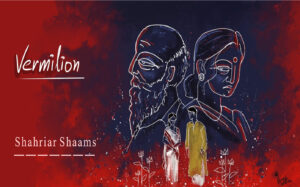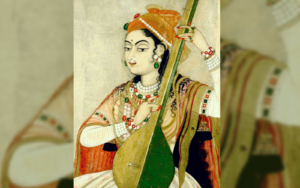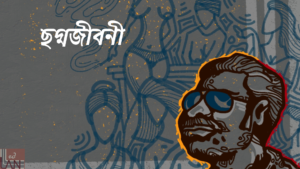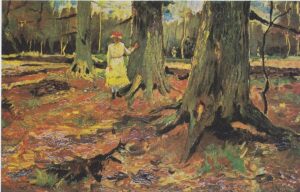There is a veritable treasure trove of contemporary literature in South Asian regional languages. Third Lane plans to go on a cross-linguistic Odyssey to bring to you, our readers, a selection of texts by emerging writers in translation. This piece has been translated from a Nepali short story, “Relli-Ko Bagar Ma Katha Tipda“, written by Solon Karthak and originally published as part of a short story collection Hastāntaran in 1996.
“Did you carry your pen, Dāju?”
Reaching for my shirt pocket, I reply, “I did, Bhāi…”
“Where are the two of you going on a day like this?” Subbeyni Didi from Deorali asks the two of us.
“Just up to the river, for a little while, Di…”
“Be careful, hai. The river might sweep you away…” Even as Didi warns us, we are already past her. In this way, we tread forward, from the soil of Bom Busty towards the Relli river with a strange zeal and inspiration.
On this side of the river stands our enchanting village Bom Busty. On the other side lies the villages of Primtam, Samthār, Samālbong, and Khani. On this side lies the Kamsi forest where we gather our firewood and fodder. On the other side, Tunang forest. In between, the Relli flows at a perpetual pace – the river which has rendered us people from this side of the river or beyond.
Here, today, on the banks of the Relli, I have come down in search of a factual story. In this enterprise of mine, I have already reached the banks with my brother in Christ, Erit. In front of us, the murky Relli tumbles down—it sweeps our gaze along with it, over across long distances. Suddenly, we catch sight of a group of men in the middle of the muddy waters of the river. We make our way towards them slowly.
“Daju! They are the ones who set the bamboos afloat!” Bhai exclaims.
I silently think to myself: I have come here to meet these poor brothers and sisters who set bamboos afloat to transport them. To listen to their stories and to tell their stories. I get near a brother who is dueling with the force of the swirling waters and enquire –
“How many bamboos are you able to set afloat in a day, after wrestling with the river and enduring injuries from stones and boulders like this?”
Pushing off a pile of bamboos towards the river, he tells me slowly –
“The three of us manage around three hundred…”
“How much money can you keep for yourself after you set that many afloat?”
In a grave manner, Dāju says, “I don’t know Bhāi! What can I say?!!—I get three-four rupees. On the other hand, after buying rice with the three rupees, it is as good as saying hāth lāgyo bhyāgutā [1].”
Our unfortunate jāti/race, after falling innumerable times in the river and camping out in the forest amongst hordes of wild animals and dangerous insects, have to work immersed in the river that runs across over four miles during the day. But the pay for this work is not adequate. Neither is their bread…
I have one more question to add, “These bamboos are for making paper, right Dāju?”
He gives me a simple answer, “That’s what they say, Bhāi! These bamboos make good quality paper it seems.”
In a flash, the truth dawns on me—we have the resources to make paper. But the plains have the factories to manufacture paper.
What if the factories were here itself? A mountain of questions arises within me, but something else flows out from my throat – “Lau/All right then, we are leaving…” We advance our steps along the river bank.
Erit Bhāi is walking ten-fifteen paces ahead of me. Rain starts to drip from the sky steadily. It seems that the people within the forests of Kamsi and Tunang are continuing to struggle against hunger and thirst, looking for firewood and fodder even on a day like this. Upon reaching further down, we come across a fisherman casting his net on murky waters as he makes his way up. In a flash, I remember the protagonist of Shivkumarji’s[2] story “Māchhā ko mol/the Value of Fish.”
“How much did you catch hau, Dāju?” Erit’s shout pierces through the sound of the river.
Indicating with his hands, he replies, “Zero……Nothing.”
We leave the man behind. A jalewā[3] flies noisily ahead of us.
After having covered some distance down the bank, I bring my tiring legs to a halt and ask “Bhai! We’ve reached ‘Septar’ right?”
“There, we’ve reached Dāju,” Bhāi replies pointing towards the houses and banana groves ahead of us.
Shifting our bags from one shoulder to the next for one last time, we reach Septar. This place lives up to its name. The ropeway that was in Riyang and Kamsi earlier now operates here. Here, the serpentine Relli that meanders across hills and forests dissolves into the strong embrace of the Teesta.
We come across a decent-looking man, a gentleman, and present our questions to him: “We have come here to learn a few things, to write about them. Would you be able to tell us about these bamboos that are brought here afloat the river waters from the Tunang jungle upstream, where these bamboos that are transported by tractors and heaped up here are taken and why…?”
‘The fitter mason lives over there. He will be able to tell you about these things properly…,’ he suggests.
Casting our glance towards the fitter’s house, we say, “All right then, thank you…” and proceed.
At that very moment, a Catholic nun alights from a cable car she has boarded from 27th mile, across the river.
‘Namaste! May we come in? We wish to know a few things from you.’
‘Come in! Do sit down!!’
We enter into the house that the fitter has built for himself in Septar; luckily, the contractor who bought the bamboos was also there. Trying to make the situation easier, we present our question: ‘How many more years will you continue to cut down the bamboos of the Tunang forest like this?’
The contractor responds, ‘According to the agreement between the company and the Forest Department, this work will continue for twelve more years—till 1986. This work was started last October…’
I think to myself that if this work will continue for twelve years, there will be work for the people here. If they have work, some of the problems will go away…. On the other hand, I think how enthusiastic students could take the time out to come down here if they so desired, for there were many things worth seeing here. They could add to their knowledge, even if it were by an inch.
Thinking over these things, I take my pen and notebook out to write down a few things. I wonder what the contractor thought when I did this—he appeared to be frightened. We wanted to know since when and how the work was going on here, but we hadn’t come to report his profit margin to the Income Tax Department. Knowing of his sankuchit prabriti, his anxious nature, we direct our other questions to the fitter, the tractor driver, and the coolies we had met there.
‘Well, Dāju! We have established that these bamboos are used to make paper, but how are these bamboos taken from the place they were cut down to the paper factories?’ We enquire of the fitter Dāju.
Fixing his big black eyes on us, he says, ‘The ones who cut them do it in the Tunang jungle. The logging is done from the lumbering site to the river bank. From the bank to this place, they are brought either by tractor or by the coolies for a wage. They take contracts to log drive them using the river waters till this point. After they arrive here, the coolies load them in the ropeway whereby they are dropped on the other side at 27th Mile. From there, Tatas and tractors transport them to New Jalpaiguri. From New Jalpaiguri, they are loaded on to trains and delivered at Sealdah Station, Calcutta. From there again, trucks and lorries transport them to the Titagarh Paper factory…’
It seems to be an efficient system of transportation. The paper we use to write and print books seems to be exported from our very courtyard. Bhāi and I exchange glances and arrive at the same conclusion.
‘Apart from Titagarh, don’t these bamboos go to other places?’ In response to my query, fitter Dāju answers, ‘They also go to another paper mill in Orissa. Just like here, currently, the bamboos from the Assam plains are being felled; those bamboos are supplied throughout India.’
The fitter mason seems to be kind-hearted. Greeting and thanking him, we express our desire to visit him again and proceed.
At that very moment, with a booming Bhat—ta—ta—, a tractor stacked with bamboo arrives. Climbing onto that very tractor, we drive along the banks of the Relli, larger than 4th Mile, and arrive at the camp of the tractor driver and the coolies.
Entering the tiny camp with everybody else, we once again place our query, ‘Brothers! Do any of you know, since last October when the work was started, how many bamboos have been transported from here…?’
Knowing the truth, the driver Dāju tells, ‘From a total of one lakh sixty thousand felled bamboo, around thirty thousand are left to be transported…’
“The whole forest seems to have been transported,” I comprehend and add, ‘And how many of you have worked since then?’
‘Around 300 have been employed. Further, 30-35 of us are working here…,’ a brother who knew the facts informs. As we emerge from their camp, we say in our turn, ‘Today we were able to learn many things from you all. Many thanks to you all…just think, from here we send out the bamboo that produces paper, but in exchange, it is us who have to purchase expensive books and copies. The bamboo we set adrift from here and the paper that is made from it is unreachable to our very children to access and write on.’ As I say this, I forcefully dislodge a bamboo that had been flowing downstream and had jammed into the river’s current, but I feel as if the bamboo were saying, “To Titagarh I don’t want to go…I don’t want to go…”
Illustration : Suman Mukherjee
*****
Annotations:
“We have caught frogs”. It is a reference to a popular Nepali phrase ‘Māchhā, māchhā, bhyāgutā’/ ‘Fish, fish, frog’ where while trying to catch fish, one would end up with frogs denotes the futility of one’s labours.
Shivkumar Rai (1919-1995), Nepali writer and author of Dak Bangla (1957) among other novels.
The Great Cormorant bird.

Solon Karthak
Solon Karthak, the recipient of the prestigious Sahitya Akademi Award (2019) for his travelogue Visva Euta Pallo Gaon or The World is the Next Village (2013) is a widely known and well-respected literary figure who has been steering the course of “niyatra” or travelogues in the Indian Nepali literary scenario. His published works are as follows:
Samudrawari Samudrapari 1976
Videshtira Ringdai Jaada 1991
Padyatra Gaonko Fanko Videshko 2000
Visva Euta Pallo Gaon 2013
Golardh Ghumaika Rangharu (Hues of the Hemisphere), 2018
A Translator’s Note:
When I met Rev. Solon at his beautiful house at Bom Busty, Kalimpong surrounded by Magnolias and the sound of local birds, I could sense that he was content at home. For a well-travelled man whose travelogues have been published under Visva Euta Pallo Gaon/ The World is the Next Village (2013), he seems to find the bucolic life of his village the most fulfilling, and his writings encourage the readers to remember their roots. The story “Relli-Ko Bagar Ma Katha Tipda”/ “Picking a Story on the Banks of Relli” is the final tale from his 1996 anthology titled Hastantaran. The seventeen stories in this book have been compiled over a period of twenty-five years from various literary publications. Although the stories range from his visit to London to a politcal rally in the Hills, or on love, the author’s intention, as he explains in his foreword, is to provide an account of his village, his neighbourhood, and their stories. Rev. Solon expresses his advocacy for environmental protection by writing about the rapid changes that industrialization and globalization have brought about in the past few decades, especially through deforestation and the extinction of native species. He carries this out through the usage of a lucid, simple style that encapsulates colloquial Nepali spoken by ordinary people from the hills. As a result, I have retained the original syntax, punctuations, and the tenses, which interspeares between the past and the present to preserve the essence of spoken Nepali and authorial intention.
As the title Hastantaran denotes, the author delegates, entrusts, and passes to us, the readers, these ‘factual stories’, for they are actual accounts of the oridnary people from his community. Perhaps, this act is marked by the way folk tales in the Darjeeling hills are transferred/ borrowed/gifted from one generation to the next. The story “Picking a Story…” refers to this same action Tipda/Tipnu which roughly translates as ‘to pick/ to pluck’. Just as the author picks up a story the way we would pick up a beautiful pebble from a river, the story is ours to possess and hand over to somebody else.









